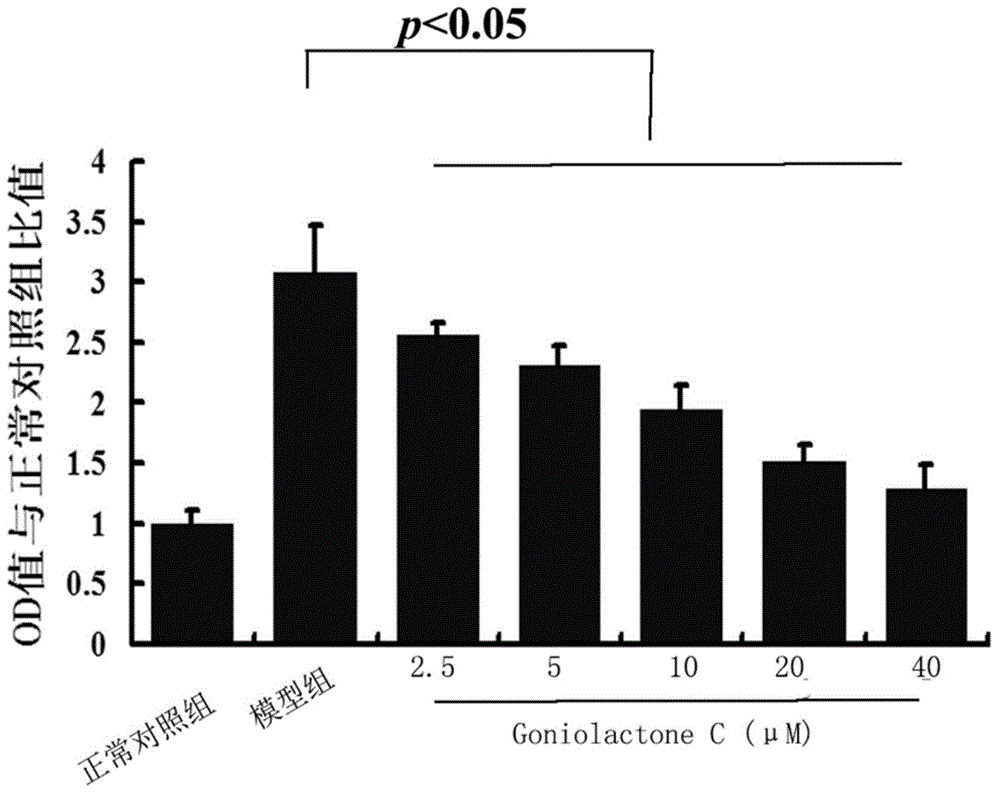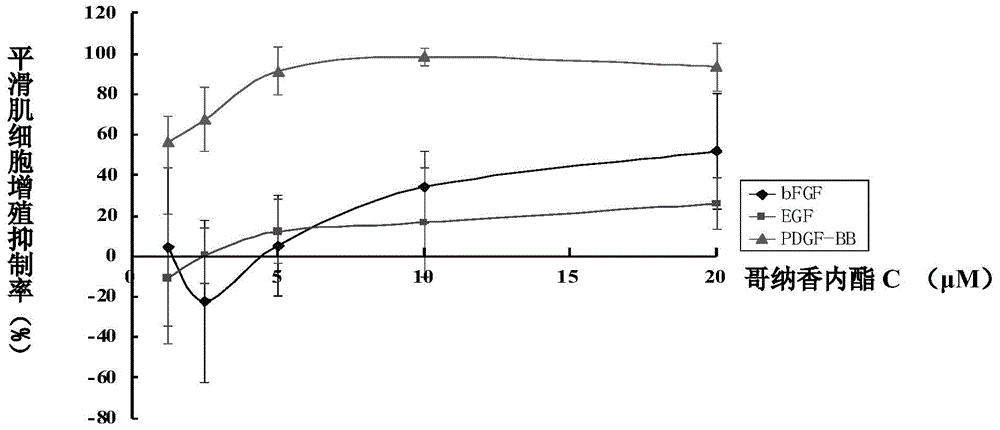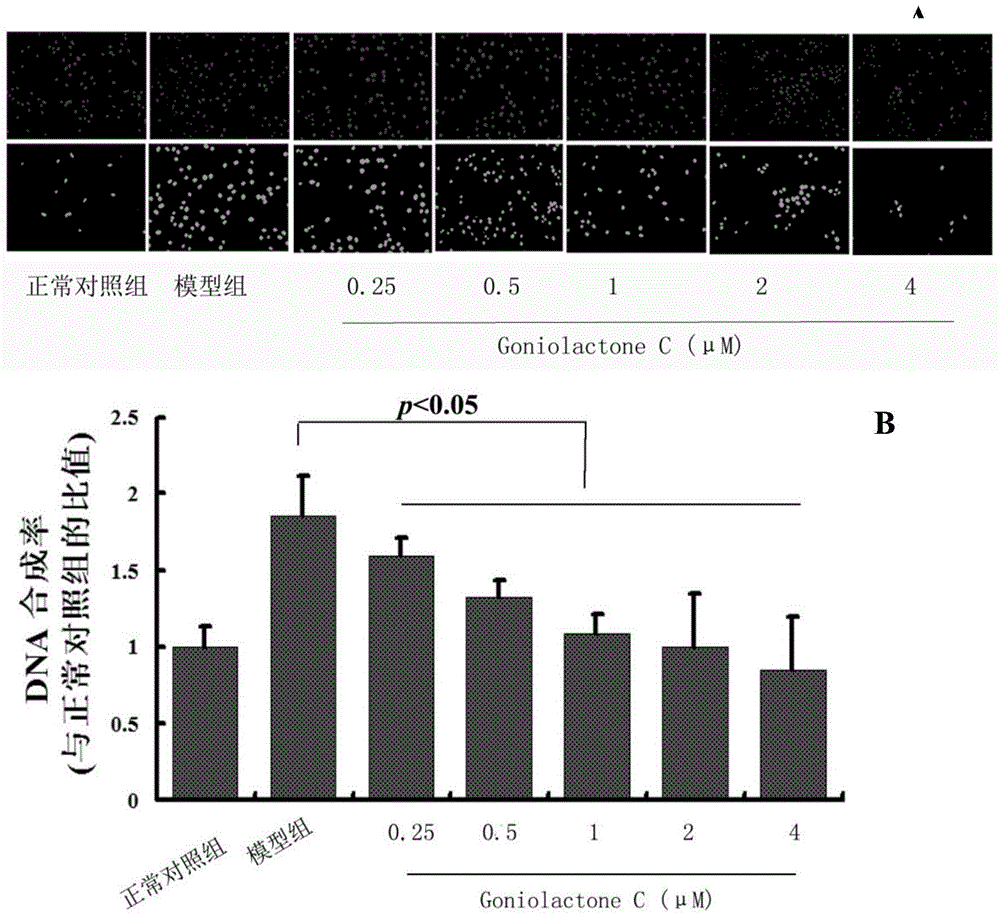Application of goniolactones C to suppressing proliferation and migration of vascular smooth muscle cells
A technology of cornalactone and smooth muscle cells, which is applied to cardiovascular system diseases, medical preparations containing active ingredients, organic active ingredients, etc., to achieve the effect of inhibiting the proliferation and migration of vascular smooth muscle cells and reducing the proliferation of smooth muscle cells
- Summary
- Abstract
- Description
- Claims
- Application Information
AI Technical Summary
Problems solved by technology
Method used
Image
Examples
Embodiment 1
[0026] Example 1. Cornalide C inhibits serum-induced proliferation of rat vascular smooth muscle cells
[0027] Experimental method: After male SD rats were decapitated, the thoracic aorta blood vessel was quickly taken out under aseptic condition, the fat layer was separated, placed in digestive solution (0.06% trypsin + 0.06% type I collagenase), and kept in the incubator Digest in medium for 20-30min; take it out, completely remove the adventitia, use tweezers to pull the blood vessel to destroy its intima, take the smooth muscle layer, cut it into pieces, and place it in a petri dish; culture it with DMEM / F12 medium + 20% FBS; Digest with 0.125% trypsin; transfer to the second generation and change the medium: DMEM+10% FBS; unless otherwise specified, the smooth muscle referred to in the present invention is P3-P5 generation. Rat vascular smooth muscle cells (VascularSmoothMuscleCell, VSMC) with 10 4 The density of each well was planted in a 96-well plate until 50% conflu...
Embodiment 2
[0033] Example 2. Cornalide C inhibits PDGF-BB-induced proliferation of rat vascular smooth muscle cells
[0034] Experimental method: the cell culture method is the same as in Example 1. Rat vascular smooth muscle cells with 10 4 The density of each hole was planted in a 96-well plate until 50% confluence, the serum was withdrawn and incubated for 24 hours, and then according to the experimental design, 0, 1.25, 2.5, 5, 10 and 20 μM cornacinolide C was added for pre-incubation for 24 hours, and then Add different concentrations of growth factors (bFGF100ng / ml, EGF10μg / ml and PDGF-BB40ng / ml) to continue incubation, discard the cell supernatant after 24h, use crystal violet staining method, observe the OD value of each group, and calculate the OD value of each dose group inhibition rate. Inhibition rate=1-[(model group OD value-blank control value)-(each dose group OD value-blank control value)] / [(model group OD value-blank control value)-(normal control group OD value-blank ...
Embodiment 3
[0039] Example 3. Cornalide C inhibits PDGF-BB-induced DNA synthesis in rat vascular smooth muscle cells
[0040] Experimental method: the cell culture method is the same as in Example 1. Rat vascular smooth muscle cells with 10 4 The density of each well was planted in a 96-well plate until 50% confluence, and the serum was withdrawn to continue incubation for 24 hours. Then, according to the experimental design, 0, 0.25, 0.5, 1, 2 and 4 μM cornacinolide C was added for pre-incubation, and after 24 hours Add PDGF-BB to a final concentration of 40ng / ml, continue to incubate for 24h, and add 10nMBrdu (sterile treatment) to each well 5 hours before the end of the experiment, continue to incubate for 24h, discard the cell supernatant, and rinse the cells with PBS. Triton-100 penetrated the cells, fixed with paraformaldehyde, blocked with BSA overnight, incubated with mouse anti-Brdu primary antibody for 4 hours, rinsed with PBST, incubated with FITC-labeled rabbit anti-mouse IgG...
PUM
 Login to View More
Login to View More Abstract
Description
Claims
Application Information
 Login to View More
Login to View More - R&D
- Intellectual Property
- Life Sciences
- Materials
- Tech Scout
- Unparalleled Data Quality
- Higher Quality Content
- 60% Fewer Hallucinations
Browse by: Latest US Patents, China's latest patents, Technical Efficacy Thesaurus, Application Domain, Technology Topic, Popular Technical Reports.
© 2025 PatSnap. All rights reserved.Legal|Privacy policy|Modern Slavery Act Transparency Statement|Sitemap|About US| Contact US: help@patsnap.com



